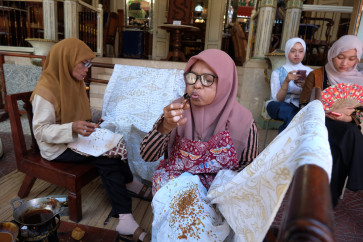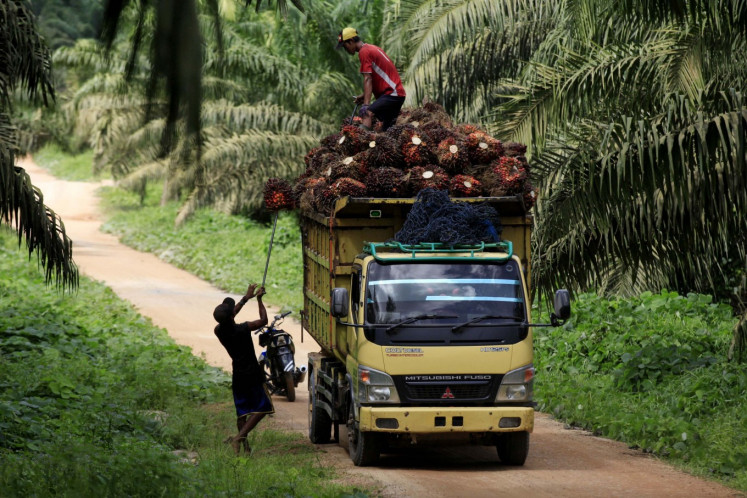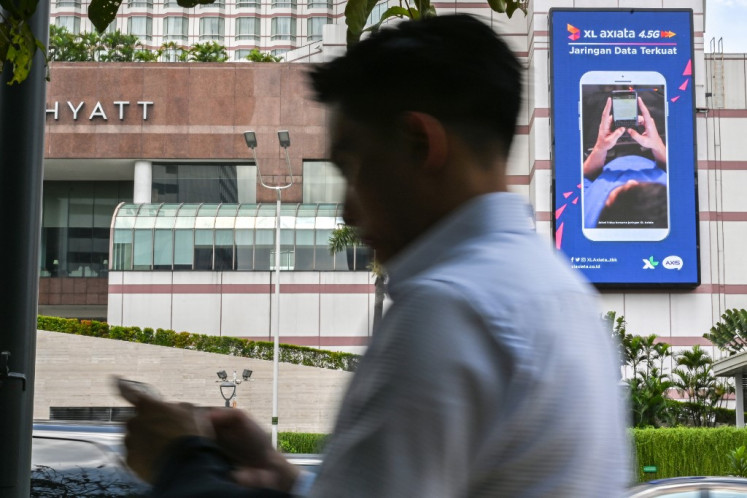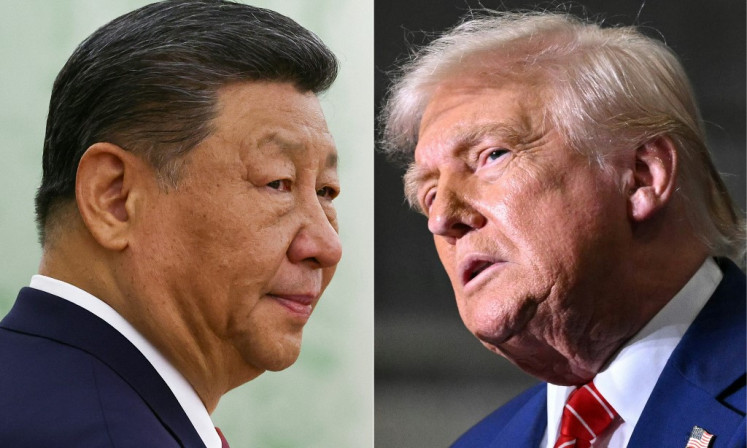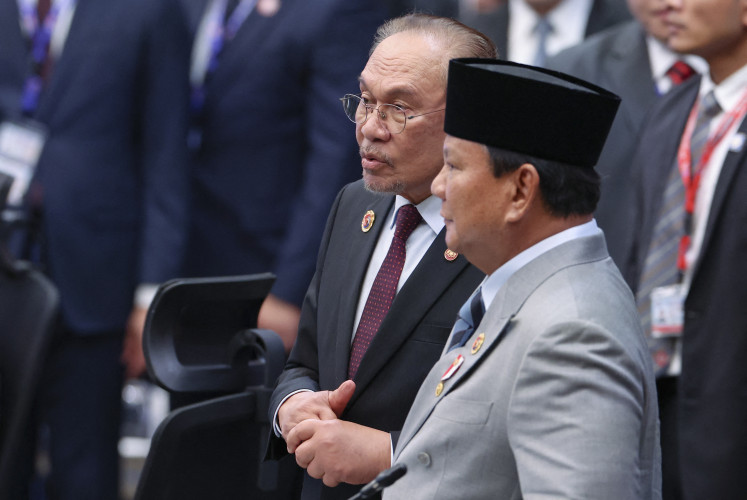Popular Reads
Top Results
Can't find what you're looking for?
View all search resultsPopular Reads
Top Results
Can't find what you're looking for?
View all search resultsWeaving the long road to 'tenun' artisan stories
On the catwalk: Models showcase a fashion collection during the 2019 World Ikat Textiles Symposium in Jakarta
Change text size
Gift Premium Articles
to Anyone
O
n the catwalk: Models showcase a fashion collection during the 2019 World Ikat Textiles Symposium in Jakarta.(JP/Tertiani ZB Simanjuntak)
For many tenun weavers, the art of the handwoven Indonesian textile is more than just a tradition — it is part of their identity and livelihood.
Yovita Meta Bastian recalls the heavy blow when a building owned by her foundation, Tafean Pah, in Biboki, East Nusa Tenggara, was torn down recently over a land dispute.
While all of the woven products had been moved safely to her house, sales stopped for a few months, which was disastrous for women in the community.
Yovita started the Tafean Pah foundation in 1990 to help an impoverished widow, whose woven products would fetch no more than the price of one stalk of corn.
“She was treated unfairly because of her status as a widow, and I just tried to help her. I noticed that woven textiles from other regions were sold commercially, whereas in my region, they were only used for traditional ceremonies,” said the recipient of the Prince Claus Award in 2003.
“We just wanted to promote and develop our local wisdom, so that we could stand on our own feet and not depend on others. I know for a fact that if we give help in whatever form, it will not lead someone out of poverty, but if their work is given a fair price, it will ensure that they have a better life.”
Yovita was one of the many artisans from across Indonesia who shared their experience over breakfast one Sunday morning at the Textile Museum in Tanah Abang, Central Jakarta.
The event was part of the World Ikat Textiles Symposium 2019, a conference celebrating ikat as a heritage textile from around the globe. Running from Aug. 23 to 25, participants came from India, Thailand, the Philippines, Malaysia, Uzbekistan, Timor Leste, France and Mexico.
Pick me: Visitors look at various fabrics and clothing offered during a bazaar held as part of the World Ikat Textiles Symposium & Exhibition at the Textile Museum in West Jakarta.(JP/Anggie Angela)Indonesian textiles are renowned for their intricate techniques passed down from generation to generation throughout the ages.
Tenun for example, features patterns with an inherent connection to the weaver’s identity, as a member of a family and a tribe.
While tenun has been undergoing a sort of revival in the Indonesian fashion scene as of late, what the public sees is clothing fashioned from the textiles, rather than tenun as an art form.
For Miki Oktyasari of Palembang, South Sumatra, the challenge is to keep the art alive. She is one of the few working to revitalize the limar method, a type of ikat (resist dye weaving) unique to the region.
“Obviously, I hope what we are doing right now can be supported by the government as well as the private sector,” Miki said.
While the limar method utilizes a technique similar to ikat, many have taken to use the simpler method of colet, which involves individually dyeing the yarn, to create limar patterns. This method is becoming more common, as it saves time by sidestepping the ikat process.
“The simple limar we see today is more practical, since it’s easier to get the color in, though the colors might not be spread too evenly. If we use the ikat [method], the colors are more even and more prominent, due to the positioning,” Miki explained.
Up close: Sapei is one of the Jakarta Textile Museum collections originating from West Kutai, East Kalimantan. The work was on display at the 2019 World Ikat Textiles Symposium & Exhibition at the Textile Museum in West Jakarta.(JP/Anggie Angela)Another hurdle is the lack of documentation, with Miki admitting she sometimes created patterns to her own liking instead of established patterns.
“I make drafts for the patterns, but when it comes to moving them to the yarn, I’ll end up adding one or two things to the final weaving.”
She said the limar skills had been passed down from their ancestors, and many of today’s weavers were reluctant to pass down their own knowledge to the younger generation, especially if they were not from the same family.
Weavers in other communities around the archipelago face the same conundrum. For them, weaving is part of their family identity and social status, so outsiders are not always welcome to share the family secret.
Ice Tede Dara of Savu, East Nusa Tenggara, said outsiders were allowed to wear the tenun, but not to weave the specific patterns.
“To wear it, you generally have to be part of the family, but you can freely wear it if you’ve bought the textile,” she said, citing that daughters would weave textiles for their mothers’ 50th birthday.
Not all communities, however, were closed off.
The Dayak Iban of Kalimantan, for example, allow outsiders to use the patterns if they pay a fee — a practice that Ice said was not allowed in Savu.
Celebrating Ikat: Visitors see the Paton Patala collection from India on display at the 2019 World Ikat Textiles Symposium & Exhibition at the Textile Museum in West Jakarta.(JP/Anggie Angela)Another challenging aspect of traditional tenun was the dyeing process.
Kornelius of East Sumba in East Nusa Tenggara explained that the popularity of natural materials had left them with a shortage of supplies.
“Some people in the district only take what is available from nature and do not cultivate the plants. We’re worried that, once they run out, no one will be using natural dyes anymore,” he said.
Kornelius is one of the few male weavers in Indonesia. Traditionally, this is attributed to harvest seasons, where women will weave while waiting for the crops to ripen.
In Sumba, Kornelius said, weaving was primarily for the purpose of tradition.
Lately however, men were becoming more involved, because they saw this as a livelihood for the family.
Kornelius said men had begun to get involved in weaving sometimes in the 1970s.
“However, women still make up the majority in some parts of the region, as there were certain things men weren’t allowed to do, such as weaving the color blue. In other cases, men were usually involved in the ikat and pattern design.” (ste)

![On the catwalk: Models showcase a fashion collection during the 2019 World Ikat Textiles Symposium in Jakarta.(JP/Tertiani ZB Simanjuntak)" width="780" height="717" border="0">On the catwalk: Models showcase a fashion collection during the 2019 World Ikat Textiles Symposium in Jakarta.(JP/Tertiani ZB Simanjuntak)</p><p>For many <em>tenun</em> weavers, the art of the handwoven Indonesian textile is more than just a tradition — it is part of their identity and livelihood.</p><p>Yovita Meta Bastian recalls the heavy blow when a building owned by her foundation, Tafean Pah, in Biboki, East Nusa Tenggara, was torn down recently over a land dispute.</p><p>While all of the woven products had been moved safely to her house, sales stopped for a few months, which was disastrous for women in the community.</p><p>Yovita started the Tafean Pah foundation in 1990 to help an impoverished widow, whose woven products would fetch no more than the price of one stalk of corn.</p><p>“She was treated unfairly because of her status as a widow, and I just tried to help her. I noticed that woven textiles from other regions were sold commercially, whereas in my region, they were only used for traditional ceremonies,” said the recipient of the Prince Claus Award in 2003.</p><p>“We just wanted to promote and develop our local wisdom, so that we could stand on our own feet and not depend on others. I know for a fact that if we give help in whatever form, it will not lead someone out of poverty, but if their work is given a fair price, it will ensure that they have a better life.”</p><p>Yovita was one of the many artisans from across Indonesia who shared their experience over breakfast one Sunday morning at the Textile Museum in Tanah Abang, Central Jakarta.</p><p>The event was part of the World Ikat Textiles Symposium 2019, a conference celebrating ikat as a heritage textile from around the globe. Running from Aug. 23 to 25, participants came from India, Thailand, the Philippines, Malaysia, Uzbekistan, Timor Leste, France and Mexico. </p><p><img class="image image-img_assist_custom-780x520 " src="http://202.158.21.182/files/images2/16-pickme.img_assist_custom-780x520.png" alt="Pick me: Visitors look at various fabrics and clothing offered during a bazaar held as part of the World Ikat Textiles Symposium & Exhibition at the Textile Museum in West Jakarta.(JP/Anggie Angela)" title="Pick me: Visitors look at various fabrics and clothing offered during a bazaar held as part of the World Ikat Textiles Symposium & Exhibition at the Textile Museum in West Jakarta.(JP/Anggie Angela)" width="780" height="520" border="0">Pick me: Visitors look at various fabrics and clothing offered during a bazaar held as part of the World Ikat Textiles Symposium & Exhibition at the Textile Museum in West Jakarta.(JP/Anggie Angela)</p><p>Indonesian textiles are renowned for their intricate techniques passed down from generation to generation throughout the ages.</p><p>Tenun for example, features patterns with an inherent connection to the weaver’s identity, as a member of a family and a tribe.</p><p>While<em> tenun</em> has been undergoing a sort of revival in the Indonesian fashion scene as of late, what the public sees is clothing fashioned from the textiles, rather than <em>tenun</em> as an art form.</p><p>For Miki Oktyasari of Palembang, South Sumatra, the challenge is to keep the art alive. She is one of the few working to revitalize the<em> limar</em> method, a type of ikat (resist dye weaving) unique to the region.</p><p>“Obviously, I hope what we are doing right now can be supported by the government as well as the private sector,” Miki said.</p><p>While the<em> limar </em>method utilizes a technique similar to ikat, many have taken to use the simpler method of colet, which involves individually dyeing the yarn, to create<em> limar </em>patterns. This method is becoming more common, as it saves time by sidestepping the ikat process.</p><p>“The simple<em> limar</em> we see today is more practical, since it’s easier to get the color in, though the colors might not be spread too evenly. If we use the ikat [method], the colors are more even and more prominent, due to the positioning,” Miki explained.</p><p><img class="image image-img_assist_custom-672x999 " src="http://202.158.21.182/files/images2/16upclose.img_assist_custom-672x999.png" alt="Up close: Sapei is one of the Jakarta Textile Museum collections originating from West Kutai, East Kalimantan. The work was on display at the 2019 World Ikat Textiles Symposium & Exhibition at the Textile Museum in West Jakarta.(JP/Anggie Angela)" title="Up close: Sapei is one of the Jakarta Textile Museum collections originating from West Kutai, East Kalimantan. The work was on display at the 2019 World Ikat Textiles Symposium & Exhibition at the Textile Museum in West Jakarta.(JP/Anggie Angela)" width="671" height="999" border="0">Up close: Sapei is one of the Jakarta Textile Museum collections originating from West Kutai, East Kalimantan. The work was on display at the 2019 World Ikat Textiles Symposium & Exhibition at the Textile Museum in West Jakarta.(JP/Anggie Angela)</p><p>Another hurdle is the lack of documentation, with Miki admitting she sometimes created patterns to her own liking instead of established patterns.</p><p>“I make drafts for the patterns, but when it comes to moving them to the yarn, I’ll end up adding one or two things to the final weaving.” </p><p>She said the <em>limar</em> skills had been passed down from their ancestors, and many of today’s weavers were reluctant to pass down their own knowledge to the younger generation, especially if they were not from the same family.</p><p>Weavers in other communities around the archipelago face the same conundrum. For them, weaving is part of their family identity and social status, so outsiders are not always welcome to share the family secret.</p><p>Ice Tede Dara of Savu, East Nusa Tenggara, said outsiders were allowed to wear the <em>tenun</em>, but not to weave the specific patterns.</p><p>“To wear it, you generally have to be part of the family, but you can freely wear it if you’ve bought the textile,” she said, citing that daughters would weave textiles for their mothers’ 50th birthday.</p><p>Not all communities, however, were closed off.</p><p>The Dayak Iban of Kalimantan, for example, allow outsiders to use the patterns if they pay a fee — a practice that Ice said was not allowed in Savu.</p><p><img class="image image-img_assist_custom-780x520 " src="http://202.158.21.182/files/images2/16-celebrating.img_assist_custom-780x520.png" alt="Celebrating Ikat: Visitors see the Paton Patala collection from India on display at the 2019 World Ikat Textiles Symposium & Exhibition at the Textile Museum in West Jakarta.(JP/Anggie Angela)" title="Celebrating Ikat: Visitors see the Paton Patala collection from India on display at the 2019 World Ikat Textiles Symposium & Exhibition at the Textile Museum in West Jakarta.(JP/Anggie Angela)](https://www.thejakartapost.com/files/images2/16-onthecatwalk.img_assist_custom-780x718.png)




